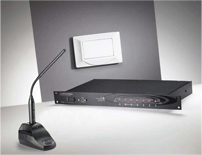Selecting The Right Microphone For Each Application
While the importance of using a quality microphone might seem to be a discussion better left to recording and live sound specialists, it’s also important for AV integrators not to forget that the microphone is the gatekeeper to any system. Much like the old zombie movie axiom, “If you kill the head then the body dies,” a microphone inappropriately utilized in the wrong application can destroy an integrator’s work in seconds. Microphones are vulnerable to many issues in a commercial setting, especially wireless models, but luckily manufacturers are taking steps to future-proof their products for the industry.
Audio-Technica SpectraPulse
Selecting the right microphone for an application can be a difficult decision to make. “Oftentimes, a contractor will see a spec calling for several mics, so they’ll just order a dozen of something on sale, and start miking drums with dynamic mics,” explained Audio-Technica’s director of educational services, Steve Savanyu. “Integrators need to look at them as tools in a tool box: what’s it going to be used for? What I’d use for a kick drum is completely different than what I’d use for the worship leader at a church. The contractor needs to be familiar with what’s out there.”
For applications like houses of worship or performing arts venues, choosing the right microphone is based on its susceptibility to stage noise. “Any mic that’s expected to operate on a stage will operate better where the overall stage volume is lower,” said Shure’s category manager for wired products, Chad Wiggens. “In the event that stage volume is higher, where someone is using floor wedges or side fill instead of in-ear monitors, that introduces all types of ambient stage levels. There are mics for that situation, but they have certain limitations with frequency response and sensitivity to noise. You could choose a mic with a wider or more flat frequency response and better noise performance, but you have to understand the circumstances needed to operate that mic best.”
Shure’s category manager for wireless products, Erik Vaveris, concurred, “It really benefits the end users. Besides saving their hearing, it saves the mics from having to compete with stage noise. I think the sound community has done a lot to bring these benefits to the people, particularly for the worship market. While it’s not a new thing, the benefits to the customer are clear, and integrators that do a lot of that work have been instrumental in bringing that practice to the market.”
Another trend that many integrators are facing is sharing RF signals with other devices on the spectrum, particularly in multi-use venues. “Susceptibility to wireless inference, like with cell phones and wireless mics is a big issue because there are tons of those around. Starting with a good site plan is best, knowing how the mics will be set in relation to each other,” noted Karl Winkler, Lectrosonics’ director of business development. “Say you have a multi-room facility, looking at a floor plan, you might see that some rooms are on opposite ends of the building, so you can get away with certain things there compared to if the rooms were next to each other. Physical layout takes first priority, then looking at what parts of the spectrum are available is next, like checking where the local TV channels fall. Then integrators should look at what manufacturers cover what parts of the spectrum are available. Some manufacturers’ products don’t fit every situation, so it’s important to research. Finally, integrators should look at how many channels are really needed.”
Savanyu agreed, noting the importance of knowing what’s going on around the facility. “We once did a job for a big catholic church with a police station next door. The police radios weren’t an issue, but when there was a big news story one morning, all the TV stations came to the police station to do a press conference, and suddenly the church was getting a ton of RF hits because no one had thought of this situation occurring. Integrators always need to be aware what’s going on around a facility.”
While there are many important components to consider with the design for a new facility, microphones should be treated as an important part of the signal chain. “Oftentimes, in the grand scheme of a project, a client is going to buy a $60,000 digital console, and then a $100 microphone,” Savanyu said. “The mic is the first link in the signal chain, and the whole system is only as good as its weakest link.”
